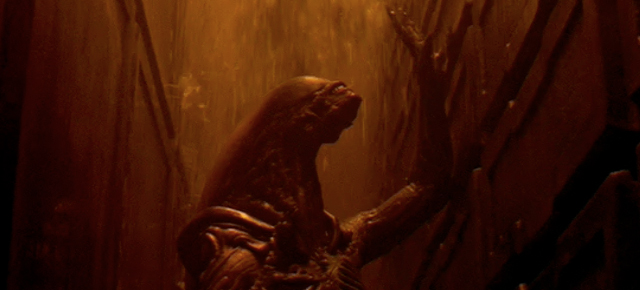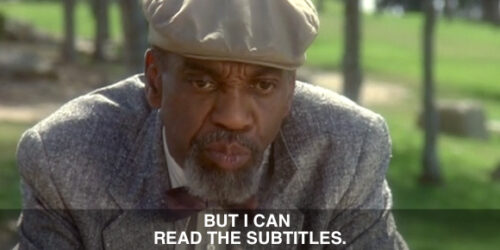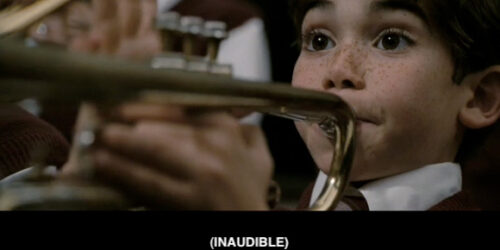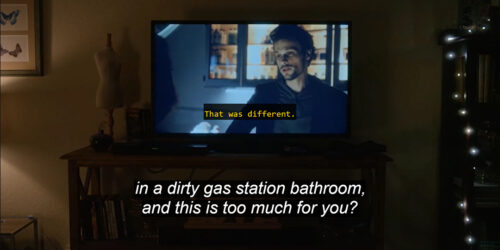Genre-defining sounds, even when they lie to us

Even when music is intended to deceive, it needs to be captioned if it’s instrumental to the genre.
When instrumental music provides ambience in a scene, does it need to be captioned? If so, how should it be captioned (e.g. with a music note, a short description, a song title, or nothing at all)? What if the scene is already packed with significant speech and non-speech sounds/captions? How do we know whether we need to make room for music captions too?
We can’t answer these questions until we’ve made a careful assessment of the meaning, function, and value of the musical sounds in a scene. If music contributes significantly to the purpose of a scene, then it probably needs to be captioned. What is the most effective way to convey a scene’s mood or intent through music captions? How can we ensure that music captions — in this case, captions for ambient music sounds — contribute to a scene and not detract from it? When are music captions not needed?
Even when music is intended to deceive viewers or lead them astray, it needs to be captioned if it’s an important means of conveying the purpose of the scene to viewers. Consider what happens at the end of Alien 3 (1992) on DVD (spoiler alert). After the alien has been covered with molten lead and presumed dead, the background music tells us it’s time to celebrate the alien’s demise. The moments following the molten lead bath are intended to be celebratory. How do we know? The music tells us so. Warning: This clip contains violent images and may not be suitable for some viewers.
There are three examples of ambient music in this clip: the pounding, anxious drum beat preceding the capture (0:00-0:12); the celebratory music of the alien’s presumed death (0:34-1:30); and the jarring sounds and rapid beat of the resumed chase (1:15 until the end). I am interested here in the triumphant, celebratory music that starts just as the rain of lead is ending and continues until the alien leaps out of the molten lead pool to strike one last time. While Morse’s laughter and speech do provide cues to viewers that it may be okay now to breathe a sigh of relief, Morse’s reaction merely provides support for the musical accompaniment. (Why should we trust Morse, anyway?) The music — with its orchestral majesty, high notes, and glorious melody — is key to drawing viewers into believing the alien must certainly be dead.
The triumphant music that starts at the end of the lead bath is intended to lull us into a false sense of security about the status of the alien. That’s how so many of these horror flicks work: 1) We think the alien or serial killer is finally dead, 2) We breathe a sigh of relief, and then 3) It/He rises again to scare the hell out of us one last time. From this perspective, the music is not merely incidental or ambient but genre-defining. The celebratory music is a generic cue in movies of this type. The cue doesn’t have to take the form of music. Music is simply one way of tricking viewers into thinking it’s finally okay to relax. The beast/alien/bad guy/serial killer/monster is dead now — oh no, wait!
So that’s why the music should have been captioned. Even though the music is deceiving, it’s part of the horror genre. The music is absolutely instrumental to conveying the lie at the end of so many flicks in this genre.
Tricking viewers is one function of ambient sounds, at least in video games. In Game Sound (2008), a book about video game music and sound design, Karen Collins discusses how ambient sounds — e.g. “music, or ambient dialogue, or…outdoor environmental sounds” (p. 92) — can create a particular mood. Ambient sounds “can be used to prepare a player for a particular situation, or to trick the player into thinking an area may be safe when it is not” (pp. 92-3).
In movies, ambient sounds can also trick us. That’s precisely what the triumphant music at the end of Alien 3 is intended to do. Because the end-of-flick trick is integral to the horror genre, it must be captioned in such a way that caption viewers are mistakenly led to believe that the area is finally safe.

[Fair use notice: The videos on this site are transformative works used in good faith, in keeping with Section 107 of U.S. copyright law, and as such constitute fair use of copyrighted material. Read this site’s full fair use notice.]






I would like to see clips from other movies that demonstrate music being used generically in this way.
Thanks, Diane. I’m working on an example now from one of the Harry Potter movies. I’ve become more interested lately in how music is captioned and, more broadly, what purpose background music plays in a scene.
Sean
You asked some good questions in the first paragraph. I don’t see how the captions can _not_ make room for music. Sometimes the whole point of a scene is carried in the music. (And sometimes there’s too much of this — e.g., cheesy violins telling us that there’s romance in the air or that sort of thing.) Just turn off the music sometime, and it is readily apparent that the music is almost as important – or maybe more so, in some cases – than the dialogue.